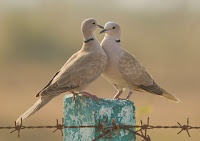EURASIAN COLLARED DOVE
EURASIAN COLLARED DOVE (Streptopelia decaocto) – (See images below)
DESCRIPTION: The Eurasian Collared Dove is grey with a hint of pink. The ‘collar’ is a fine black line at the nape base. Wing primaries are dark grey. Tail is square and under tail is black near the rump and white at the edge. Eyes are black with a white eye ring. Bill is black and upper mandible is slightly longer. Legs and feet are pinkish grey. Sexes are similar. Bird length is around 13 inches (32 cm).
VOICE: https://www.xeno-canto.org/species/Streptopelia-decaocto
NAME: ‘Dove’ means ‘to dive’, in reference to the bird’s irregular flight. ‘Collared’ refers to bird’s neck plumage, similar to a (partial) collar. Latin genus name ‘Streptopelia’ means ‘collar’ and ‘dove’. Latin species name ‘decaocto’ means ‘eighteen’ and refers to a Greek mythology story where a maid was changed into a dove.
HABITAT: Fields, suburban and urban areas.
DIET: Seeds, grain, including at backyard feeders, also insects and berries, even garbage.
NESTING: Nest is built in trees not far from the grounds, sometimes on buildings. About two white eggs are laid, incubated by both parents. Chicks are fed ‘crop milk’ by parents.
DISTRIBUTION: Introduced in the Bahamas in the 1970s, spread to Florida and now to southeast USA, and continues to spread. Native range covers southeast Asia, also widespread in Europe. Usually a year-round resident.
Distribution Map: Native and introduced ranges: https://en.wikipedia.org/wiki/Eurasian_collared_dove#/media/File:Streptopelia_decaocto_range_map.png
ON PEI: Does not breed on Prince Edward Island, sightings listed as ‘accidental’ so far. See note below on bird vagrancy. This species has first been reported on the island in March and April 2013.
CONSERVATION: Widespread and still spreading, not at risk. Adapts well to human environments. Its impact on native species in North America remains to be seen.
Vagrancy: In biology this means an animal going way outside its normal range. For birds, this can happen when there are storms and they get blown off course. On other times, the bird simply wanders in a different direction than usual. Here’s an article about vagrancy in birds.
SIMILAR SPECIES: Mourning Dove, Spotted Dove
REFERENCES: https://www.tn.gov/twra/wildlife/birds/grassland-and-shrub-birds/eurasian-collared-dove.html (Tennessee Wildlife Resources Agency)
https://app.bto.org/birdfacts/results/bob6840.htm (British Trust for Ornithology)
http://identify.whatbird.com/obj/887/overview/Eurasian_Collared-Dove.aspx
http://www.oiseaux-birds.com/card-eur-collared-dove.html
https://en.wikipedia.org/wiki/Eurasian_collared_dove
https://www.allaboutbirds.org/guide/Eurasian_Collared-Dove/id
https://www.audubon.org/field-guide/bird/eurasian-collared-dove
DESCRIPTION: The Eurasian Collared Dove is grey with a hint of pink. The ‘collar’ is a fine black line at the nape base. Wing primaries are dark grey. Tail is square and under tail is black near the rump and white at the edge. Eyes are black with a white eye ring. Bill is black and upper mandible is slightly longer. Legs and feet are pinkish grey. Sexes are similar. Bird length is around 13 inches (32 cm).
VOICE: https://www.xeno-canto.org/species/Streptopelia-decaocto
NAME: ‘Dove’ means ‘to dive’, in reference to the bird’s irregular flight. ‘Collared’ refers to bird’s neck plumage, similar to a (partial) collar. Latin genus name ‘Streptopelia’ means ‘collar’ and ‘dove’. Latin species name ‘decaocto’ means ‘eighteen’ and refers to a Greek mythology story where a maid was changed into a dove.
HABITAT: Fields, suburban and urban areas.
DIET: Seeds, grain, including at backyard feeders, also insects and berries, even garbage.
NESTING: Nest is built in trees not far from the grounds, sometimes on buildings. About two white eggs are laid, incubated by both parents. Chicks are fed ‘crop milk’ by parents.
DISTRIBUTION: Introduced in the Bahamas in the 1970s, spread to Florida and now to southeast USA, and continues to spread. Native range covers southeast Asia, also widespread in Europe. Usually a year-round resident.
Distribution Map: Native and introduced ranges: https://en.wikipedia.org/wiki/Eurasian_collared_dove#/media/File:Streptopelia_decaocto_range_map.png
ON PEI: Does not breed on Prince Edward Island, sightings listed as ‘accidental’ so far. See note below on bird vagrancy. This species has first been reported on the island in March and April 2013.
CONSERVATION: Widespread and still spreading, not at risk. Adapts well to human environments. Its impact on native species in North America remains to be seen.
Vagrancy: In biology this means an animal going way outside its normal range. For birds, this can happen when there are storms and they get blown off course. On other times, the bird simply wanders in a different direction than usual. Here’s an article about vagrancy in birds.
SIMILAR SPECIES: Mourning Dove, Spotted Dove
REFERENCES: https://www.tn.gov/twra/wildlife/birds/grassland-and-shrub-birds/eurasian-collared-dove.html (Tennessee Wildlife Resources Agency)
https://app.bto.org/birdfacts/results/bob6840.htm (British Trust for Ornithology)
http://identify.whatbird.com/obj/887/overview/Eurasian_Collared-Dove.aspx
http://www.oiseaux-birds.com/card-eur-collared-dove.html
https://en.wikipedia.org/wiki/Eurasian_collared_dove
https://www.allaboutbirds.org/guide/Eurasian_Collared-Dove/id
https://www.audubon.org/field-guide/bird/eurasian-collared-dove
 |
| Eurasian collared dove, Charles J. Sharp |
 |
| Eurasian collared dove juvenile, Juan Emilio |
 |
| Eurasian collared doves, Dhaval Vargiya |